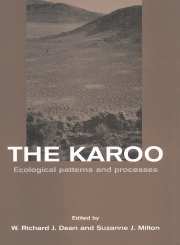Book contents
- Frontmatter
- Contents
- List of contributors
- Foreword
- Preface
- Acknowledgements
- Part one Biogeographic patterns and the driving variables
- 1 The climate of the karoo – a functional approach
- 2 Soils of the arid south-western zone of Africa
- 3 Palaeoenvironments
- 4 Plant biogeography, endemism and diversity
- 5 Biogeography, endemism and diversity of animals in the karoo
- Part two Form and function
- Part three Dynamics
- Part four Human impacts
- Part five Comparisons
- References
- Index
2 - Soils of the arid south-western zone of Africa
Published online by Cambridge University Press: 23 December 2009
- Frontmatter
- Contents
- List of contributors
- Foreword
- Preface
- Acknowledgements
- Part one Biogeographic patterns and the driving variables
- 1 The climate of the karoo – a functional approach
- 2 Soils of the arid south-western zone of Africa
- 3 Palaeoenvironments
- 4 Plant biogeography, endemism and diversity
- 5 Biogeography, endemism and diversity of animals in the karoo
- Part two Form and function
- Part three Dynamics
- Part four Human impacts
- Part five Comparisons
- References
- Index
Summary
Introduction
Soils represent the interface between the lithosphere and the atmosphere where the elements in inorganic minerals are released for utilization in the organic biosphere. In arid to semi-arid regions, soils form slowly (Buol, 1965; Dan, 1973; Dunne et al., 1978) and are an important control of the abundance and distribution of plants and animals (Leonard et al., 1988), as has been demonstrated in the karoo (Van Rooyen and Burger, 1974; Vorster, 1986; Vorster et al., 1987; Palmer et al., 1988; Lloyd, 1989a). The objective of this chapter is to give an overview of the soils across the arid south-west of Africa and to outline some general controls due to geology, geomorphology and climate. The summary will be confined to the karoo south of the Orange River because that is the only portion with a reliable soils map (Ellis and Lamprechts, 1986; Ellis, 1988).
For the purposes of this chapter, the karoo has been subdivided into 6 regions on geological, geomorphological and pedological factors: (1) west coast, (2) Namaqualand, Bushmanland and Korannaland, (3) Great Karoo (north), (4) Great Karoo (south), (5) Little Karoo and (6) Great Escarpment (Fig. 2.1). These subdivisions do not quite correspond to the biogeographic regions of the karoo (Hilton-Taylor and Le Roux, 1989). The succulent karoo biome occurs in Region 1, the western parts of Regions 4 and 6, and Region 5, while the Nama-karoo biome is found over the rest of the area.
Controlling factors on soil variability
General factors
Soil is a mixture of inorganic and organic particles with variable amounts of water and air.
- Type
- Chapter
- Information
- The KarooEcological Patterns and Processes, pp. 17 - 26Publisher: Cambridge University PressPrint publication year: 1999
- 9
- Cited by



